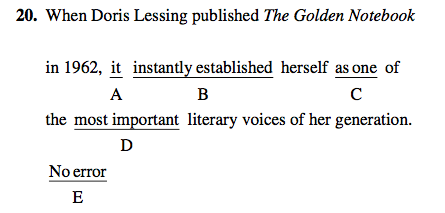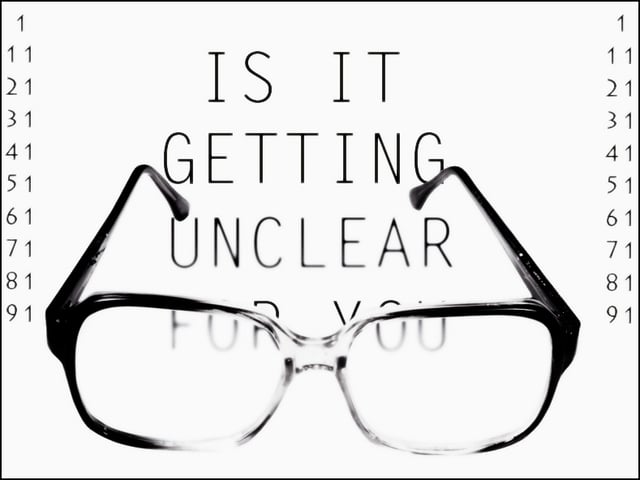
Pronoun agreement errors are some of the most common on the SAT Writing section, and they can be confusing because people often misuse pronouns, especially when we speak. In fact, I just made a pronoun mistake: can you spot it?
Take a closer look at the second half of my first sentence: "people often misuse pronouns, especially when we speak." Who is "we" referring to here: "people." However, the correct pronoun for the third person plural is they. The correct version is "people often misuse pronouns, especially when they speak."
On SAT Writing, you'll be expected to spot many such errors. We'll be covering both the basic SAT writing rules regarding pronouns you need to know and the common mistakes you'll see on the test:
- Pronouns and Antecedents
- Disagreement in Number
- Disagreement in Person
- Unclear Antecedents
- Spotting Pronoun Errors on the SAT
A Pronoun Must Always Match its Antecedent
That title might seem confusing. What's an antecedent? And what does it mean to "match"? The truth is you probably already have an intuitive grasp of how this works, but let's break it down one piece at a time.
What's a Pronoun?
A pronoun is a word that takes the place of a noun—that's it! Usually we think of pronouns as words like I, him, they, or its, all of which are definitely pronouns. But so are words like everyone, which, and each. Any word that can fill in for a noun is a pronoun. For more detailed information on pronouns, take a look at our guide to parts of speech.
What's an Antecedent?
An antecedent is the noun a pronoun replaces. (You may also have heard these called referents.) Let's look at an example—the pronoun is in bold and the antecedent is underlined:
Julie almost forgot her backpack this morning.
Simple enough, right? "Her" is standing in for "Julie's." Let's try a more complicated one:
Running out the door to meet Jimmy, Julie almost forgot to grab his bag, which he'd left at her house the night before.
There's a lot more going on in this sentence, so I've color coded the pronouns and their nouns. The trick here is figuring out who's doing what. Jimmy forgot his bag at Julie's house; now she's bringing it back to him. When looking for pronoun agreement errors, keep an eye out for any sentences that don't track clearly in this way.
What Does It Mean for a Pronoun and Antecedent to Match?
Again, though this concept may sound confusing, it's actually pretty intuitive. Let's revisit our example from above, with a slight tweak:
Julie almost forgot our backpack this morning.
This sentence clearly isn't correct. That's because the pronoun "our" and the antecedent "Julie" don't agree; Julie is third person singular and our is first person plural. They disagree in case and number. It's also possible for a pronoun and an antecedent to disagree in person:
Julie almost forgot my backpack this morning.
Julie is a proper noun and should take a 3rd person pronoun, not a 1st person pronoun like "my." While "Julie almost forgot my backpack this morning" is grammatically correct, it changes the meaning, which is a no-go on the SAT; your grammar corrections shouldn't involve transferring ownership of someone's backpack.
As a review, the most common pronouns and their correct uses are listed below:
- I/me/my — first person singular, i.e. the person speaking
- We/us/ours — first person plural, i.e. the person speaking and others
- You/your — second person (singular and plural), i.e. the person (or people) being spoken to
- He/him/his — third person masculine, i.e. a male person or animal who isn't present
- She/her — third person feminine, i.e. a female person or animal who isn't present
- It/its — third person neuter, i.e. inanimate objects
- They/them/their — third person plural, i.e. multiple people or things. (They/them/their is also used in everyday speech as third person singular, but whether "they" should or shouldn't be singular for individual humans is not a usage the SAT will test you on.)
Moral of the story: pronouns must always have a clear antecedent and agree with the noun that they replace. Now that we've established what that means, let's look at the errors you're likely to see on the SAT.

Make sure your pronouns aren't like this llama. (© Valdrec)
Disagreement in Number
I mentioned above that plural nouns require plural pronouns and singular nouns require singular pronouns. Usually, that rule feels pretty obvious: it doesn't make much sense to refer to Tom as "them" or the Muppets as "it." However, this is the SAT we're talking about, so the errors are going to be a little harder to spot. Let's go over some of the trickiest cases.
Extra Words
In a simple sentence, it's easy to spot number agreement errors:
Incorrect: The kids want her own TV.
Correct: The kids want their own TV.
Catching these errors gets much trickier when we add in more words, however:
Because Susie and her brother begged their dad for a TV, he agreed to get one for her.
At first glance, this may seem fine—Susie's getting a TV! But let's look at each pronoun and its antecedent:
- her = Susie
- their = Susie and her brother
- he = their dad
- her = Susie and her brother
The TV isn't just for Susie, it's for both siblings. As such, the sentence should read:
Because Susie and her brother begged their dad for a TV, he agreed to get one for them.
When you're dealing with pronouns on the SAT, the first step is always to determine what its antecedent is. This will make it much easier to figure out the correct pronoun to use.
Collective Nouns
Collective nouns are similarly confusing, because they refer to more than one thing or person as a singular entity. Take, for example, "the class." The class may include multiple students, but there is still only one class. It's a singular noun and therefore takes a singular pronoun.
Incorrect: For their final assignment, the class had to build a dancing robot.
Correct: For its final assignment, the class had to build a dancing robot.
Correct: For their final assignment, the students in the class had to build a dancing robot.
"They" may seem like the proper pronoun to use for a collective noun like "class" because it is made up of multiple individuals, but the noun itself is singular, so "it" is correct.
Collective nouns can be tricky to spot, so be on the lookout for nouns that refer to groups of people. The team, the band, the company, and the town are all examples of collective nouns.
SAT Examples
Let's take a look at how to spot this type of error in an Identifying Sentence Errors question from a real SAT.

Reading over this sentence, you might not notice anything wrong since it sounds fine. The next step is to check each underlined section for errors. In this case, C includes a pronoun, so you must check agreement. And what's the first step to check agreement? Find the antecedent!
For "they," the antecedent is "a Shakespearean character," which is singular. As such, "they have" is incorrect and C is the answer. You don't even have to think about how to fix the error, just spot it! (But in case you're wondering, the correct version would be "he has" or "she has.")
Disagreement in Person
Pronoun agreement in person is a slightly weirder concept than agreement in number, but it's usually pretty easy to spot. The basic concept is that a pronoun must reflect the type of thing it's replacing. So you use "it" to replace "the garden" but "he" to replace "Abraham Lincoln."
Like with agreement in number, the first step is making sure that you know what a pronoun's antecedent is. Beyond that it's mostly just a question of consistency—if you start a sentence in the first person, you shouldn't suddenly switch to the third without a clear reason.
I was on my way home when he saw a butterfly.
This series of events is entirely possible, but it doesn't make much sense as a sentence. Another incorrect sentence:
Right after the bomb beeped, he exploded.
Again, it's theoretically possible that there's some guy who exploded, but from the context it seems pretty clear that it was the bomb, and inanimate objects can't be referred to as "he."
These examples are pretty simple, but once again the test writers are likely to throw you some curveballs. Let's take a look at some of the harder-to-spot types of errors.

This is a disagreement between genders, not a disagreement in gender.
You vs. One
When explaining how to do something (like I'm doing right now), you can use either "you," in the non-specific sense, or "one," as in "an individual." Both are equally correct: "you" is simply less formal than "one." However, you must be consistent and stick with whichever pronoun you pick; it would sound pretty weird if I suddenly switched to saying "one needs to find the antecedent." Let's look at how that works in a sentence:
Incorrect: If one wants to succeed on the SAT, you must study effectively.
Correct: If one wants to succeed on the SAT, one must study effectively.
Correct: If you want to succeed on the SAT, you must study effectively.
The incorrect sentence uses two different pronouns, while the corrected versions stick to one or the other.
Errors with you and one are very common on the SAT Writing, so watch out for sentences where either word is underlined.
Relative Pronouns
The other tricky case with disagreement in person is relative pronouns like who and which. Each of these words is used to refer to a specific type of thing:
- Who and whom — a person (on the SAT you will not be tested on difference between the two)
- When — a point in time
- Where — a place (use "in which" for media)
- Which and that — anything else
Even though you don't necessarily think of these types of pronouns as having antecedents, they still do, and that means they have to agree with those nouns. Here's an example of an incorrect sentence:
I found the gummi bears who I'd lost under my sister's bed.
Who or what is "that"? Well, it's "the gummi bears." Gummi bears aren't a person, so it's incorrect to use "who" to refer them. The correct version is:
I found the gummi bears that I'd lost under my sister's bed.
Let's look at a slightly trickier case.
I finally got to the chapter where the hero sneaks into the castle and rescues the dragon.
This sentence sounds fine, but what is "where" referring to? "The chapter" isn't actually a place, so we need to use "in which" instead:
I finally got to the chapter in which the hero sneaks into the castle and rescues the dragon.
When you see a relative pronoun on the SAT, make sure that it is the correct one for describing the type of thing that it is referring to.
SAT Writing Example Questions
For the Identifying Sentence Errors questions, you can look for problems with agreement in person in the same way you look for issues with agreement in number: determine the antecedent for any underlined pronouns and ensure that they match.

Choices A and C both involve pronouns. In C, "one" is fine, since it's referring to Doris Lessing, who is a singular person. A is a bit trickier. At first glance, "it" seems fine—it's standing in for "The Golden Notebook."
But if we fit that antecedent back into the sentence we get, "The Golden Notebook instantly established herself as one of the most important literary voices of her generation," which clearly doesn't make sense. It's Lessing, not her novel, who established herself, so the correct pronoun would be "she." A includes the error, so it's the correct answer.
Remember to watch out for you vs. one and relative pronouns, as well. Let's look at an example of a question involving these topics:
Psychologists advise that before making any major changes in your life, a person needs to focus on one's goals.
(A) your life, a person needs to focus on one's goals
(B) their lives, focus on the goals
(C) one's life, you should focus on your goals
(D) their lives, people should focus on their goals
As written, the underlined portion of this sentence uses two different possessive pronouns, "your" and "one's," neither of which agree with the antecedent, "a person." Choice C has a similar mistake—it uses both "your" and "one's," when any given sentence can either use "you" or "one." B cuts out the antecedent all together, creating a sentence that doesn't make sense.
Eliminating these choice leaves only D, which is the correct answer, since the 3rd person plural pronoun "their" is used appropriately with the 3rd person plural antecedent "people."
Unclear Antecedents
We've covered the basic rules for ensuring that pronouns agree with their antecedents, but a lot of the pronoun questions on the SAT Writing are designed to confuse you by not having a clear antecedent. It's important to remember that a pronoun's antecedent must be a noun and you must be able to circle it in the text. In other words, it's not enough for you to know what the pronoun is referring to, the antecedent also has to be obvious in the text.
Your vision may be unclear, but make sure your antecedents aren't. (© xWoliex)
No Antecedent
I know I've said this a couple of times already, but it's the most important thing to remember about pronouns on the SAT Writing: every pronoun must have an antecedent. I'm emphasizing this because sometimes you'll see a pronoun that doesn't have one:
In order to get the spelunking permits from the office, I need them to call me back.
Who does "them" refer to? Presumably, the people who work in the spelunking permit office, but there's nothing in the sentence to specifically indicate that. A correct version might read:
In order to get the spelunking permits, I need someone from the office to call me back.
Now it's clear who I need to call me back. Similarly, you'll sometimes see a verb or adjective used as an antecedent—this is incorrect.
People who crawl through caves do it because they love adventure.
This sentence seems fine; "it" is clearly "crawl through caves." However, "crawl" is a verb, not a noun, and thus cannot serve as an antecedent.
People who crawl through caves do so because they love adventure.
This kind of error can be especially confusing because gerunds, the "ing" forms of verbs, are technically nouns and can be used as antecedents for pronouns.
Incorrect: I explore underwater caves often; it is fun.
Correct: I love exploring underwater caves; it is fun.
"Exploring" is a correct antecedent; "explore" is not. Always make sure that a pronoun's antecedent is a noun you can point to in the sentence.
Too Many Antecedents
Another common antecedent issue occurs when a sentence has more than one noun that could be the antecedent. For example:
When Nel and Katie got back from the movie, they took her dog for a walk.
It's unclear whether "her" refers to Nel or Katie. The possessive either needs to be replaced with something more specific or removed:
When Nel and Katie got back from the movie, they took Nel's dog for a walk.
When Nel and Katie got back from the movie, they took their dog for a walk.
When Nel and Katie got back from the movie, they took the dog for a walk.
On the SAT Writing, watch out for sentences that involve two or more names of the same gender, since that construction often indicates this type of error.
This, Which, and That
In casual English, we often use the pronouns this, which, and that without clear antecedents.
Liz: My mom told me I have to stay home and clean my room.
Wayne: That's annoying.
This construction may be fine in spoken English, but it would be absolutely incorrect on the SAT. This, that, and which must have clear noun antecedents, just like any other pronoun. Let's look at an example:
It took me 24 hours to travel from Los Angeles to Mumbai; this meant that I was very tired when I reached my destination.
What is "this"? It's somewhat unclear, but there are a few ways we can improve this sentence.
It took me 24 hours to travel from Los Angeles to Mumbai; this fact meant that I was very tired when I reached my destination.
It took me 24 hours to travel from Los Angeles to Mumbai, so I was very tired when I reached my destination.
Both are perfectly clear; however, on the SAT, the second option would be preferable because it is more concise.
SAT Writing Example Questions
Missing or unclear antecedents pop up fairly frequently on the SAT and they can be hard to spot. Let's look at some examples, starting with Identifying Sentence Errors:
Neither Mr. Weasley nor (A) Mr. Potter thinks (B) that eating as much candy as his (C) daughter Jen does will result (D) in anything good. No error (E)
The underlined pronoun in C, "his," seems fine—it matches the antecedent in person (3rd person masculine) and number (neither takes singular pronouns and verbs). But it's actually unclear who "his" is referring to: is Jen Mr. Weasley's daughter or Mr. Potter's? It's impossible to tell, so this construction is incorrect.
Let's move on to an Improving Sentences question:

Again, at first glance, this sentence looks correct. However, "that" requires an identifiable noun antecedent, which it doesn't have. "That" is referring to the tearing down of the Berlin Wall, but that phrase doesn't appear in the sentence, nor does any equivalent noun phrase. Choices B and D also feature pronouns without antecedents.
E is not idiomatic, which leaves C, the correct answer.

You have to watch for errors as vigilantly as this meerkat is watching for predators.
How to Spot a Pronoun Agreement Error on the SAT Writing
As you've seen in the SAT Writing examples, pronoun agreement errors appear in both the Identifying Sentence Errors questions and the Improving Sentences questions. There are slight differences in how these errors are tested in the two sections, however.
Identifying Sentence Errors
Pronoun errors are among the most common on the ISE section, so any time you see a pronoun underlined, you must always check for an antecedent and make sure that the pronoun and antecedent agree.
Underlined nouns can also indicate pronoun agreement errors, although they usually mean that there's a subject-verb agreement issue, which is slightly different.
On the Identifying Sentence Errors, these constructions often indicate a pronoun agreement error:
- More than one name of the same gender
- "One" or "you" underlined
- "It" or "they" underlined
- Collective nouns
- Names of professions
Though sentences with these clues are especially likely to have a pronoun agreement, you should still make sure to check that any underlined pronoun matches its antecedent. For more details on how to systematically check sentences for errors, see our post on how to approach Identifying Sentence Errors questions.
Improving Sentences
Pronoun agreement errors are also relatively common on the Improving Sentences, and you should expect to see some questions dealing with them. However, you likely don't want to check every underlined pronoun, as on the ISE, since they are often part of more complicated constructions with which there are many other possible problems. (For example, pronouns are often used as filler in wordiness questions.)
Certain sentence structures pop up again and again, though, so there are some clues you can watch out for. The following signs—some of which also appear on the ISE section—often warn of a pronoun agreement issue:
- That, which, or who underlined
- A pronoun, especially it, near the beginning of a sentence
- The presence of "you" or "one"
- Collective nouns
For a more complete rundown of best practices for the Improving Sentences questions, check out our post on strategies for the IS section.
Test Your Knowledge!
Now that we've covered the ins and outs of pronoun agreement on the SAT, why don't you take a crack at some realistic SAT writing practice questions?
1. The herd of black-and-white cattle bellowed (A) loudly as (B) the cowboys herded them (C) into the expansive (D) pen. (E) No error
2. My sister loves books where (A) the villains win, but (B) my brother prefers those (C) in which good triumphs over (D) evil. (E) No error
3. The more time one spends on the baking of cookies, the less you'll want to eat them.
A. one spends on the baking of cookies
B. you spend baking cookies
C. he spends to make cookies
D. that is spent on the baking of cookies
E. one bakes cookies
4. When the ninja finally tried skiing, he didn't have fun, which confused his friends.
A. which confused his friends
B. that confused his friends
C. which his friends found confusing
D. by which his friends were confused
E. a fact that confused his friends
Answers: 1. C, 2. A, 3. B, 4. E
What's Next?
The only topic the SAT Writing tests more than pronouns is verbs. Make sure to study subject-verb agreement as well!
Maybe you're more concerned about the essay? In that case, take a look at our guides on how to score a perfect 12, how to plan your examples in advance, and 15 ways to improve your score.
For more big picture strategies, try these 8 key tips or check out our guide to reaching an 800 on the SAT Writing.
Want to improve your SAT score by 160 points?
Check out our best-in-class online SAT prep program. We guarantee your money back if you don't improve your SAT score by 160 points or more.
Our program is entirely online, and it customizes what you study to your strengths and weaknesses. If you liked this Writing and grammar lesson, you'll love our program. Along with more detailed lessons, you'll get thousands of practice problems organized by individual skills so you learn most effectively. We'll also give you a step-by-step program to follow so you'll never be confused about what to study next.
Check out our 5-day free trial:
Have friends who also need help with test prep? Share this article!

Alex is an experienced tutor and writer. Over the past five years, she has worked with almost a hundred students and written about pop culture for a wide range of publications. She graduated with honors from University of Chicago, receiving a BA in English and Anthropology, and then went on to earn an MA at NYU in Cultural Reporting and Criticism. In high school, she was a National Merit Scholar, took 12 AP tests and scored 99 percentile scores on the SAT and ACT.



































 Holly R.
Holly R.